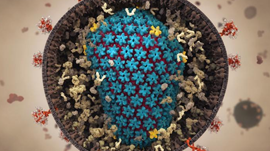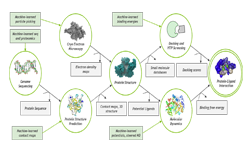University of Illinois scientists used two GPU-accelerated supercomputers to simulate the behavior of 64 million atoms to capture 1.2 microseconds of the life of an HIV capsid. The simulation offers new insights into how the virus senses its environment and completes its infective cycle.
“We are learning the details of the HIV capsid system, not just the structure but also how it changes its environment and responds to its environment,” said research scientist Juan R. Perilla, who led the study with physics professor Klaus Schulten. Such details could help scientists find new ways to defeat the virus, Perilla said.
The capsid simulation was performed on the Tesla GPU-accelerated Titan supercomputer at Oak Ridge National Lab, and the data analysis required a second supercomputer, Blue Waters, at the National Center for Supercomputing Applications at University of Illinois.
The HIV capsid is made up of hundreds of identical proteins arrayed in a network of six-sided and five-sided structures, each with a tiny pore at its center. The capsid contains the virus’s genetic material, hiding it from host cell defenses. It also transports the virus to the cell nucleus, which it must infiltrate to complete infection.
The new study revealed several properties that likely enhance the capsid’s ability to sense its environment and find its way to the nucleus, Perilla said. It showed, for example, that different parts of the capsid oscillate at different frequencies. These oscillations likely transmit information from one part of the capsid to another, he said.
It also revealed that ions flow into and out of the capsid pores. Negative ions accumulate on the positively charged surface inside the capsid, while positive ions adhere to the outside, which carries a negative charge.
The simulations reveal critical details about the capsid with implications to biological function and can be used to develop new drugs to defeat the HIV virus by targeting its capsid.
Read more >
Supercomputers Reveal How the HIV Virus Moves
Jul 20, 2017
Discuss (0)

Related resources
- GTC session: How Artificial Intelligence is Powering the Future of Biomedicine
- GTC session: How AI Will Decode Biology to Radically Improve Lives
- GTC session: Poster Reception (Sponsored by Cadence)
- NGC Containers: GROMACS
- Webinar: Accelerating Large-Scale Genomics Research
- Webinar: Bringing Drugs to Clinics Faster with NVIDIA Computing









